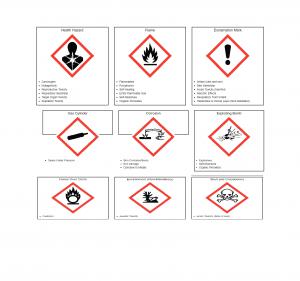GHS Pictographs - concept applied to food safety Procedures - not compatible with visual communication through visual communication, which also suppo
through visual communication, which also supports ongoing FSMA compliance
SARASOTA, FL, UNITED STATES, November 24, 2020 /EINPresswire.com/ — Mr. Frank Yiannas, Deputy Commissioner for Food Policy and Response, stated ‘scientific knowledge and policies are not enough to achieve food safety sustainably in an organization. Measures that raise individual awareness and lead to actual behavior changes are required from the perspective of social-behavioral sciences. That is the basic idea of food safety culture’.
The GFSI TWG defines food safety cultures as “shared values, beliefs, and norms that affect mindset and behavior toward food safety in, across and throughout an organization.” The GFSI in its position paper ‘A CULTURE OF FOOD SAFETY A POSITION PAPER FROM THE GLOBAL FOOD SAFETY INITIATIVE (GFSI)’ suggests the following food safety communication channels to affect the food safety cultural change.
• Mentoring
• Feedback/Suggestions process Company Intranet and message boards Competitions
• Buddy program
• Gemba Kaizen circle meetings
• Posters
• Meetings
• Briefings
• Videos
• Phone calls
• Conferences
• Shift Huddles
• Digital Coaching
• Awards and recognition
• Consequences (Including disciplinary actions up to the termination
Guidance on HOW to conduct communication leading to a food safety cultural behavioral change is offered in this discourse.
Social behavioral science
At https://blog.prepscholar.com/average-sat-scores-over-time shows that in 2016 SAT recorded its lowest average score of 494 before its redesign the following year. Referencing Raven’s Tests, the change likely because Visual IQ is rising faster than any other form of IQ. Research also revealed that the average time before a person gets distracted is 8 seconds. 81% of educated persons skim instead of reading online and that 20% is all that persons remember from text. Prior to 2018, it was predicted that 84 % of all communication would be visual in that year. These statistics indicate a visual communication approach is needed to improve the food safety culture. What are the potential methods to conduct communication visually?
The Global Harmonization Standard
OSHA approved requirements for ‘chemical manufacturers and importers to label chemical containers with 1) a harmonized signal word 2) GHS pictogram(s) 3) a hazard statement for each hazard class and category and 4) a precautionary statement. A harmonized signal word is used to indicate the relative level of severity of hazard and alert the reader to a potential hazard on the label. The signal words are "danger," used for the more severe hazards, and "warning," which is used for less severe hazards’. Food safety can create the same visualization design of pictographs for Biological, Chemical, Physical, Allergens, Disease, Threats and Vulnerabilities et al to be placed on raw material and product packaging along the supply chain, with the same four GHS characteristics. Over time the food safety information will be inculcated subliminally and consciously to facilitate an improved culture. The pictograph's visualization from farm to fork will create awareness as a start for culture change.
Looping Videos
'How-to' preventive controls are on looping videos to be made available on electronic monitors for visualization. The looping videos are juxtaposed to work centers / critical control points.
Mobile app application
The typical method for food safety plans and preventive controls as encouraged by FSMA is the written procedures. It is not unusual for procedures to be located away from the point of use and rarely referenced – because of the inconvenience of working paper procedures or memorizing for each product food safety plan at the point of use.
‘fsma SaaS’ recognizes the deficiency of the current practices to shift the culture at the point of application of the food safety plan / preventive controls. ‘fsma SaaS’ can deliver 8-second snippets instructions to avoid distractions. Memorization is not needed because the attendant scans a bar code to reach the food safety plan/ preventive control snippet. An extended-paper procedure document (more than 8 seconds) is avoided. The mobile format – allows the user to gain a full understanding of food safety at a specific point of use with the knowledge constantly in front of the attendant. The mobile negates any training method associated with memorization.
Factors for Culture change
According to the NeuroLeadership Institute Forbes (David Rock May 24, 2019), three factors contribute to organizational culture change. Visual communication can satisfy the stated parameters.
(a)Employees need to understand new priorities ‘These priorities need to be easily recallable, sticky ideas that make complete sense with everything else going on and get people thinking in new ways. They need to appear desirable, as well as feasible’.
• The GHS inspired pictographs et al is proven communication. It will drive the understanding of the new food safety priorities because the raw material/product is accompanied by the identified pictograph
(b) Building new habits ‘The second step, the harder work, involves building true habits that support these priorities. Building habits take time and attention, it doesn’t happen by just wanting to’.
• The looping video displays the correct ‘how to’ way to conduct the preventive controls and be easily viewed at the work center. For example – cleaning techniques related to the hazard, specific to the work center.
(c ) A system ‘The third step involves systems that support everything, to keep the priorities and habits alive’
• The system of ‘fsma SaaS’ and its apps. The specific raw material & product food safety plan/preventive controls 8 seconds snippet instruction is on the attendant’s tablet at the barcoded work center. The material/product packaging with the pictograph et al as the priority at each stage of the workflow. while the looping video demonstrates the how-to, applicable to the work center to maintain the habit, related to the preventive control.
NeuroLeadership Institute's factors satisfy Mr. Yiannis' recognition of measures of social-behavioral sciences and the GFSI's 'norms that affect mindset and behavior' to enable a food safety culture change.
Jeffrey Lewis
fsma SaaS
+1 650-269-6506
email us here
Visit us on social media:
LinkedIn
![]()

